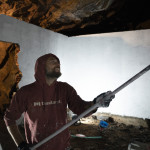“Logo al Rogo” – Mrfijodor @ Bunker H, Bolzano 2020
“Logo al Rogo” @ “Bunker Walls – Street Art Inside the Cave”, Bunker H di Bozen, September 2020. “Logo al Rogo” is a piece by Mrfijodor for “Bunker Walls – Street Art Inside the Cave” at Bunker H in Bozen (Italy). The exhibition “Mythos. Ten impressions” is organized by Cooperativa Talia and MurArte Bolzano. The wall comes from the theme “Memory and oblivion”: the one is a constant motion of the human mind, the other erases memories and consciences to start a “new cycle” of reminiscences. But there are events that cannot be forgotten, such as the atrocities of the Second World War. The artwork blends art with history: the chromatic fidelity to the Nazi flag contrasts with the provocation of the piece: the swastika is made up of glasses, shoes, teeth, prosthesis of hands and feet, all those “personal objects” of which the deportees were deprived to become what Primo Levi in “I sommersi e i salvati” calls as “human material”. The work is also a sign of contemporaneity. Some speeches and attitudes of current sovereigns create and feed useless violence born from the manipulation of everyday life: symbols, concepts, promises and intentionally repeated gestures of which these “powerful” make it their leitmotif to conquer and subjugate more or less indirectly peoples.
h
“Logo al Rogo” @ “Bunker Walls – Street Art Inside the Cave”, Bunker H di Bolzano, Settembre 2020. “Logo al Rogo” è l’opera realizzata a settembre 2020 per “Bunker Walls – Street Art Inside the Cave” al Bunker H di Bolzano. La mostra “Mythos. Dieci impressioni” – organizzata dalla Cooperativa Talia e da MurArte Bolzano. “Logo al Rogo” nasce dal tema “Memoria e oblio”: se l’una è un continuo motore della mente, l’altro lava ricordi e coscienze per ricominciare un “nuovo ciclo” di reminiscenze. Ma ci sono eventi che non si possono dimenticare, come le atrocità della Seconda Guerra Mondiale. Nel muro, l’arte si fonde con la storia: La fedeltà cromatica alla bandiera nazista si contrappone la provocazione dell’opera: la svastica si compone di occhiali, scarpe, denti, protesi di mani e piedi, tutti quegli “oggetti personali” di cui venivano privati i deportati così da diventare quello che Primo Levi ne “I sommersi e i salvati” definisce come “materiale umano”. L’opera è anche un segnale sulla contemporaneità. Alcuni discorsi e atteggiamenti di attuali sovranisti creano e alimentano di continuo violenze inutili nate dalla manipolazione della quotidianità: simboli, concetti, promesse e gesti volutamente ripetuti di cui questi “potenti” ne fanno il loro leitmotiv per conquistare e assoggettare più o meno indirettamente i popoli.

